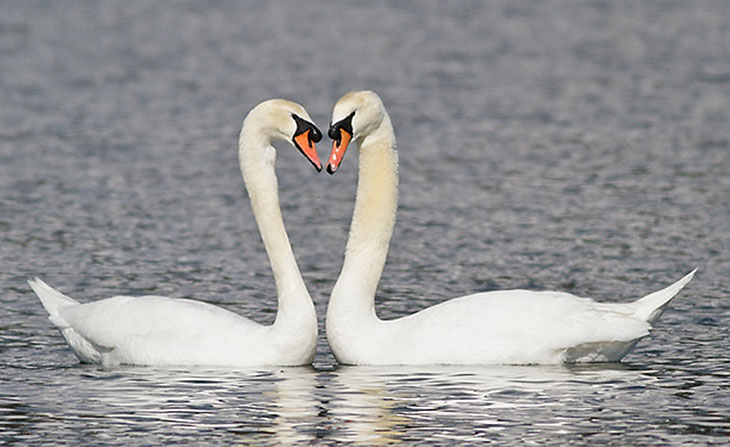Mute Swans (Cygnus olor) are majestic species of waterfowl known for their graceful appearance with their long necks, elegant white plumage, and striking orange beaks.
They’re native to Eurasia but have been introduced to many parts of the world, including North America.
Although their beauty and grace might draw you in, be careful – they are very territorial and will attack when they feel that their mate or cygnets are threatened.
Adult
Adult Mute Swans are very large birds measuring 50-60 inches long and weighing 17-26 pounds. They have short black legs, heavy bodies, and graceful and slender necks that they hold in a slight S-shape.
They have an all-white plumage and an orange bill with a black tip and knob at the base of it. The sexes look the same. The only difference is that the male Mute Swans and their knobs are generally larger than females.
Juvenile
Mute Swans usually lay 2-7 blue-green eggs that change their color to pale greenish or whitish and become chalky. The female Mute Swan incubates the eggs for 34-41 days and the male replaces her only when she’s off foraging for food.
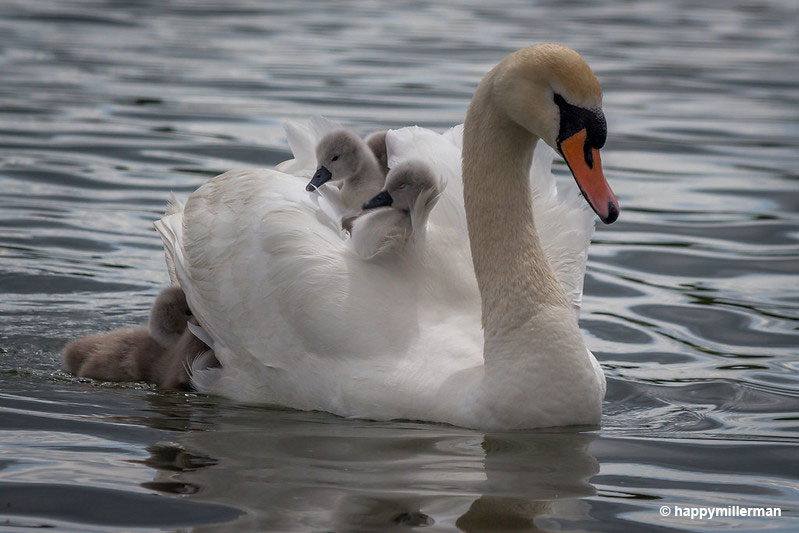
Both parents take care of the young and when their offspring are still small and young, the parents may carry them on their backs. The cygnets fledge in 4-5 months and remain with their parents until the next breeding season.
Juvenile Mute Swans look like smaller and dirtier versions of adults. Younger ones are covered in pale gray down and have black bills and legs whereas older juveniles and immatures have white plumage with grayish-brownish patches on their bodies and pale dusky bills.
Diet
Mute Swan’s habitats include both fresh- and saltwater habitats, most often near humans. They can be found in lakes and ponds, near rivers and streams, open marshes, coastal lagoons, and well-sheltered bays.
Mute Swans nest near the water, most often on a heavily vegetated shoreline, a mound, a small island, or a peninsula. The nest itself is a mound of twigs and stems of different nearby plants, such as reeds, sedges, rushes, and cattails that is lined with down. It measures 5 feet across, 1.5-2 feet high, and the cup diameter is 3-10 inches deep and 15 inches across.
Behavior
Mute Swans mate for life and are highly territorial, which is why you might see just one pair on smaller lakes and ponds. However, they can be colonial when the habitat offers enough food. Non-mated juveniles seem to be more social, forming large flocks, whereas mated birds seek out their own place.
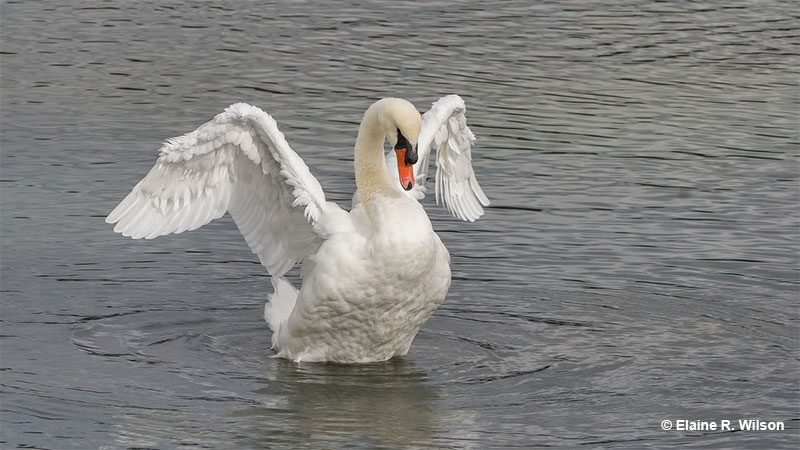
Mute Swan showing its aggressive side
Those big birds can be very aggressive when defending their nests, mates, and offspring. They assume a defensive pose, curving their neck back and raising their wings halfway, and hiss. When that is not enough to drive the intruder away, they will attack whatever threatens them, including humans.
Range (and seasonal changes)
Mute Swans range throughout most of Europe. They were introduced to North America in the late 19th century and their numbers have been increasing rapidly. Most common in the northeastern United States, the swans there don’t migrate further than absolutely necessary. In Europe, they may undertake longer migrations.
Mute Swans are listed as of least concern on the IUCN Red List. It has a wide range in Eurasia and its introduction to North America was so successful its spread started to pose a threat to native wildlife. On the other hand, they’re highly susceptible to lead poisoning, avian influenza, and oil spills.
Wing shape
Mute Swan’s wingspan may be as long as five times their body size and measure 82-94 inches long. They have large, broad wings that have slots at the end of the wings which aid with capturing the air. The primary feathers of the wings are arranged in a slightly upward curve, allowing for more lift during takeoff and flight. The wings are designed for powerful and sustained flight.
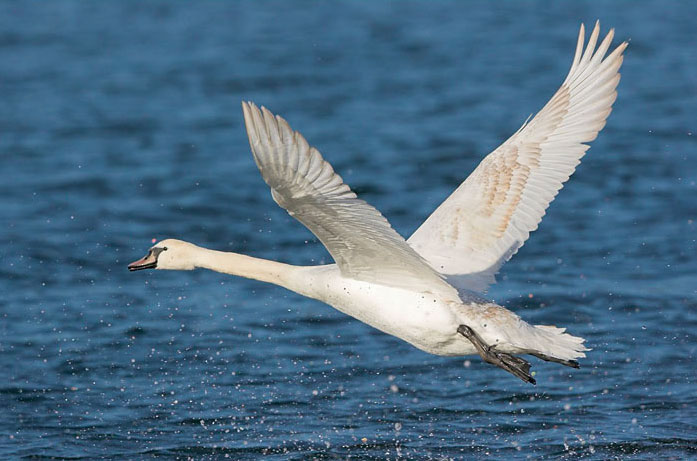
In addition to flight, swans also use their wings for communication and territorial displays. During aggressive interactions with other swans, they will raise their wings and stretch them out to appear larger and more intimidating.
Fun Facts
- Mute Swan’s wingspan may be as long as five times their body size and measure 82-94 inches long.
- Mute Swans were introduced to North America in the late 19th century. They have now established themselves and even become a possible threat to the survival of the native swan species.
- Mute Swans have an average lifespan of 7 years in the wild. The oldest wild Mute Swan lived to be 26 years and 9 months old. In captivity, they can live up to 30 and 40 years of age.
- Mute Swans got their name from the fact that they’re far less vocal than other swans.
- Usually, swan cygnets are gray or white with “dirty” patches when it’s older but still not an adult. However, there are some completely white cygnets. This is not because they are albinos, but because they carry a leucistic gene.
- Mute Swans are highly aggressive. They will attack anything they perceive as a threat, including humans, and although their hits aren’t strong enough to break a leg (as some myths claim) then they are known for sometimes dragging dogs into the water and drowning them.
Call
Mute Swans have a few different sounds and calls, although they usually remain silent. Adults hiss and snort when disturbed or threatened. Mates may snort to greet each other. Females call their mate with a slow glock call and their cygnets with a sound that resembles a puppy trying to bark.
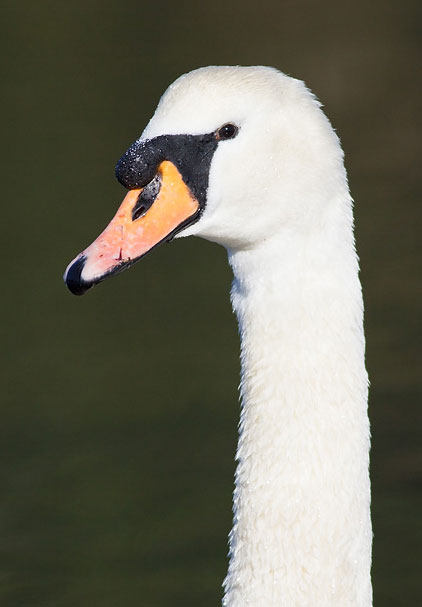
FAQ
What is special about Mute Swans?
Mute Swans are one of the heavies flying birds and form life-long bonds. They go through a grieving process when their mate or cygnet dies.
What is the difference between a swan and a Mute Swan?
In North America, the native swan species have black bills whereas Mute Swans have orange bills with black tips and black knobs at the base of their bill.
Do Mute Swans migrate?
In North America, Mute Swans do not migrate or migrate only locally. In the northern parts of Eurasia, they do migrate.
How aggressive are Mute Swans?
Mute Swans are highly protective of their mate, nest, and cygnets. They are very aggressive when protecting them and will attack any perceived threat, including humans.
Are Mute Swans intelligent?
Mute Swans are intelligent and can remember specific persons and their deeds for a long time.

